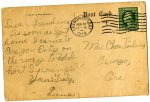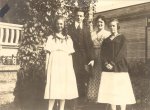
Linus Pauling's Adolescence (1910-1917)
1910
During the summer, Belle and the children move from their home on 45th Street to a three-story, ten-room house at 1189 Hawthorne Avenue near its intersection with 40th Street. Belle borrows heavily to purchase the house, which she hopes, by her taking in roomers and boarders, will provide a living for herself and her children.
In the fall, Linus, Pauline, and Lucile return to Sunnyside Grammar School.
1911
Linus begins collecting insects. Using books from the Portland library, he reads about insects and classifies his collection.
1912
Linus begins collecting minerals. With the help of a book on elementary mineralogy he borrows from the public library, he classifies his minerals in terms of their properties. He copies out tables from this book that lists minerals in order of their hardness, color, luster, specific gravity, and so on. He puts these tables on the wall of the workroom he has built for himself in the basement of the boardinghouse.
In the autumn, Belle Pauling supports Woodrow Wilson for president. She also begins reading Elbert Hubbard, a free-lance newspaper writer whose homespun philosophy she finds comforting.
Linus undergoes a religious crisis, concludes that the miracle stories in the Bible cannot be true, and becomes an atheist (a conversion that he keeps to himself).
1913
Linus has a tonsillectomy and also becomes ill with what may have been diphtheria.
In the summer, the Paulings spend two weeks on the Oregon coast (the only vacation of this type that the family ever takes).
In the fall, Linus begins his last term at Sunnyside Grammar School. He meets Lloyd Jeffress (who will later become his best friend).
1914
At the start of the year, Linus graduates from grammar school. He completes the requirements of Portland’s nine-grade, individual progress system more rapidly than most students.
In February, he enters Washington High School. In his first term, he takes English, Latin, history, elementary algebra, and gym.
In the summer, war breaks out in Europe. According to the mature Pauling, his attitude toward the war is "conventional." He simply accepts the majority view. During this time, Belle takes Linus and his sisters on a nostalgic trip to Condon.
In the fall, Linus begins his first full year at Washington High School and takes his first science course, physiography.
A short time after returning to school, Lloyd Jeffress asks Pauling if he would like to see his bedroom chemical laboratory. Pauling agrees, and Jeffress performs a chemical experiment in which he reacts sulfuric acid with a mixture of sugar and potassium chlorate, causing a dramatic formation of a steaming product of black carbon. Linus is so impressed that he decides to become a chemist. He sets up his own laboratory in his basement workroom and begins performing experiments.
1915
During his spring term at Washington High School, Linus takes plane geometry, which he very much enjoys.
In the fall, Linus’s cousin Mervyn Stephenson stops by to see the Pauling family on his way to Oregon Agricultural College (OAC), where he plans to study highway engineering. Linus learns from him that chemical engineering is also taught at OAC (from this conversation, Pauling picks up the idea that chemical engineering is the profession that chemists pursue, an idea that will remain with him for several years).
1916
In the spring term at Washington High School, Linus takes his first semester of chemistry.
In the fall, he begins his last year at Washington High School. He takes solid geometry and chemistry (in which he gets A’s) as well as Latin and English (in which he gets C’s).
1917
At the start of the spring term, he signs up for two semesters of American history, but when the principal refuses to give him permission to take both courses simultaneously (since they are sequential), Linus decides to take college algebra and trigonometry instead (even though he knows that both American history courses are required for a high-school diploma). He also takes English, Latin, and physics, and William V. Greene teaches him a special course in college chemistry (he is the only student in the course).
Shortly before the semester’s end, Linus applies for admission to Oregon Agricultural College. He has sufficient high-school credits to be admitted to OAC (and a diploma is not necessary).
In the summer, Linus gets a job in a machine shop that manufactures freight elevators. His first paycheck is $75 a month, but by the end of the summer he is making $100 a month. So impressed is his boss by Pauling’s work that he offers Linus $150 a month if he will stay on. Belle wants her son to accept this offer and abandon his college plans, but Pauling insists on going to OAC.
Table of Contents
- The Ancestry of Linus Pauling (The Paulings)
- The Ancestry of Linus Pauling (The Darlings)
- Linus Pauling's Childhood (1901-1910)
- Linus Pauling's Adolescence (1910-1917)
- Pauling's Years as an Undergraduate at Oregon Agricultural College, Part 1 (1917-1919)
- Pauling's Years as an Undergraduate at Oregon Agricultural College, Part 2 (1919-1922)
- Linus Pauling as a Graduate and Postdoctoral Student at the California Institute of Technology, Part 1 (1922-1923)
- Linus Pauling as a Graduate and Postdoctoral Student at the California Institute of Technology, Part 2 (1924-1926)
- A Guggenheim Fellow in Europe during the Golden Years of Physics (1926-1927)
- Early Career at the California Institute of Technology (1927-1930)
- Pauling's Great Years of Achievement in Structural Chemistry, Part 1 (1931-1932)
- Pauling's Great Years of Achievement in Structural Chemistry, Part 2 (1933-1935)
- Pauling's Increasing Involvement in Molecular Biology (1936-1939)
- The War Years, Part 1 (1940-1942)
- The War Years, Part 2 (1943-1945)
- The Postwar Years, Part 1 (1946-1947)
- The Postwar Years, Part 2 (1948-1949)
- Proteins, Passports, and the Prize (1950-1954)
- Increasing Involvement in World Peace, Part 1 (1955-1958)
- Increasing Involvement in World Peace, Part 2 (1959-1963)
- The Center for the Study of Democratic Institutions (1964-1967)
- The University of California, San Diego (1968-1969)
- Stanford University (1969-1972)
- An Institute for Science and Orthomolecular Medicine, Part 1 (1973-1977)
- An Institute for Science and Orthomolecular Medicine, Part 2 (1978-1981)
- The Years Alone: Pauling after the Death of Ava Helen, Part 1 (1982-1988)
- The Years Alone: Pauling after the Death of Ava Helen, Part 2 (1989-1994)
- About the Author



